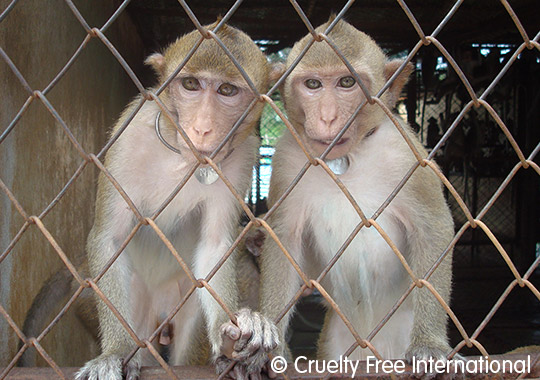We expose major cargo airline flying monkeys to a fate worse than death
Shocking facts about the transport of monkeys for experiments will make you go bananas
 Our investigation team has discovered that AirBridgeCargo, the largest Russian cargo airline, is transporting monkeys from China to laboratories in the US where they will likely be forced to suffer in cruel experiments. You can help end the suffering by writing to them here.
Thanks to your support, many of the world’s major passenger airlines no longer take part in this cruel trade. Sadly, some airlines continue to be involved in this ugly business. Here are SIX shocking facts about the trade in monkeys to laboratories that will make you go bananas:
Our investigation team has discovered that AirBridgeCargo, the largest Russian cargo airline, is transporting monkeys from China to laboratories in the US where they will likely be forced to suffer in cruel experiments. You can help end the suffering by writing to them here.
Thanks to your support, many of the world’s major passenger airlines no longer take part in this cruel trade. Sadly, some airlines continue to be involved in this ugly business. Here are SIX shocking facts about the trade in monkeys to laboratories that will make you go bananas:
- Monkeys used in experiments are often the children of monkeys who were trapped in the wild and are held captive inside large scale breeding farms in countries like Mauritius, China, Vietnam, Indonesia and Cambodia.
- Between 2011-2015, over 200,000 long-tailed macaque monkeys were traded globally for the animal research industry, primarily to the US, Europe, Japan and China.
- In Mauritius alone, tens of thousands of monkeys are imprisoned behind bars on concrete in large breeding farms. Youngsters are torn from their families to be later exported overseas to laboratories in Europe and the US.
- Once they are ripped from their family groups, little do these intelligent and sensitive animals know they are destined to spend their lives in a metal cage, thousands of miles away from their jungle homes where they are likely to be forced to suffer in experiments that can cause them pain and suffering.
- Monkeys destined for laboratories are typically packed into small wooden crates as cargo, usually too small to allow them to stand up, and forced to travel in a dark and noisy cargo hold.
- They are then flown thousands of miles to laboratories across the world. During these flights, the monkeys may be forced to endure inadequate ventilation, noise, temperature fluctuations and long delays. There have been incidents when monkeys have become ill or even died on the way.
